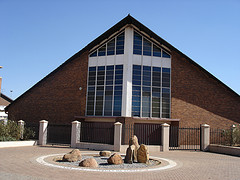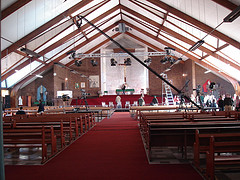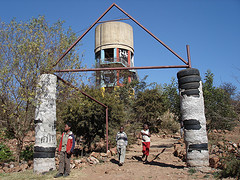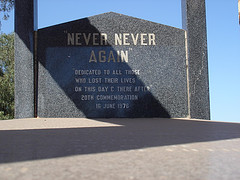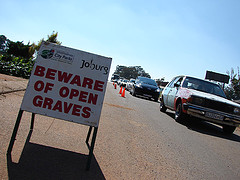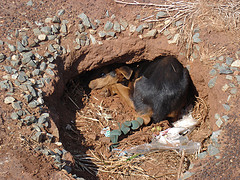The Avalon Memorial Route
Date: 08 August 2006
Route Guide: Ali Hlongwane (Curator HPMM)
Documenter: Ismail Farouk
The Avalon Memorial Route is the symbolic funeral route taken in remembrance of all those who lost their lives during the Soweto Uprisings. Thirty years ago, in the aftermath of the violence, a mass burial was planned for the dead. An application to hold a mass burial was made to the Johannesburg Chief Magistrate - This application was denied. Further attempts to list all the dead were foiled by the police as the bereaved families were denied access to the bodies of the dead. It was Dr MotlanaâÂÂs suggestion to hold a symbolic mass burial service to symbolise all the dead. The symbolic funeral service was conducted on Hector Pieterson at Regina Mundi Church (Mashabela 1987). Every year since then a special service is held at the church to commemorate the events of June 16 1976 followed by a procession to the Avalon Cemetery.
On the 08th of August 2006, Ali Hlongwane and I retraced the Avalon Memorial route from the Regina Mundi Church on the Old Potchefstroom Road. The Regina Mundi Church is a Roman Catholic Church and BishopâÂÂs residence. The facility opened in 1962 and has been the scene for many mass gatherings of people over the years.
On this day, a very different kind of gathering was happening. CNN, the global media giant, was hosting a live public broadcast from the Regina Mundi Church. The broadcast was aimed at examining the state of the nation a decade after emerging from the isolation of apartheid.
After a brief inspection of the interior of the Regina Mundi Church, we drove down the Old Potchefstroom Road in a westerly direction. A short while later, we turned left into Sibasa Street in Chiawelo and traveled in a southerly direction.
We past the famous SOMOHO water tower on a little hill. SOMOHO stands for Soweto Mountain of Hope. The site is a community cultural initiative which transformed the barren, dangerous hill into a beautiful cultural centre.
We continued south and soon we reached the entrance of the Avalon Cemetery. Avalon Cemetery is one of the largest cemeteries in South Africa and is the final resting place of many political and cultural activists. The cemetery is about 170ha in size and is managed by the City of JohannesburgâÂÂs City Parks division. At the entrance to the cemetery, a memorial with the words, âÂÂNever Never Againâ inscribed on it pays tribute to those who lost their lives in the Soweto uprisings of 1976.
One of the many problems experienced at the cemetery include the digging up of graves by wild dogs. Some graves have been âÂÂfencedâ off using metal structures which resemble little beds in order to protect them from wild animals.
With more than 200 funerals occurring each weekend, Avalon Cemetery is facing severe pressure. The death rate is increasing by 10% per year. Cremation is not considered appropriate for most people so City Parks are encouraging families to consider the âÂÂsecond burialâ option, where several members of a family are buried in the same grave. Compounding the problem is the Aids pandemic. With more than 6.5 million of the country's 47 million people infected with HIV, demand for space is increasing. Every weekend, convoys of buses carrying mourners bring the Old Potchefstroom Road to a standstill. This has resulted in special traffic marshals being deployed to deal with the traffic congestion every weekend.
Route Guide: Ali Hlongwane (Curator HPMM)
Documenter: Ismail Farouk
The Avalon Memorial Route is the symbolic funeral route taken in remembrance of all those who lost their lives during the Soweto Uprisings. Thirty years ago, in the aftermath of the violence, a mass burial was planned for the dead. An application to hold a mass burial was made to the Johannesburg Chief Magistrate - This application was denied. Further attempts to list all the dead were foiled by the police as the bereaved families were denied access to the bodies of the dead. It was Dr MotlanaâÂÂs suggestion to hold a symbolic mass burial service to symbolise all the dead. The symbolic funeral service was conducted on Hector Pieterson at Regina Mundi Church (Mashabela 1987). Every year since then a special service is held at the church to commemorate the events of June 16 1976 followed by a procession to the Avalon Cemetery.
On the 08th of August 2006, Ali Hlongwane and I retraced the Avalon Memorial route from the Regina Mundi Church on the Old Potchefstroom Road. The Regina Mundi Church is a Roman Catholic Church and BishopâÂÂs residence. The facility opened in 1962 and has been the scene for many mass gatherings of people over the years.
Figure: Regina Mundi Church
On this day, a very different kind of gathering was happening. CNN, the global media giant, was hosting a live public broadcast from the Regina Mundi Church. The broadcast was aimed at examining the state of the nation a decade after emerging from the isolation of apartheid.
After a brief inspection of the interior of the Regina Mundi Church, we drove down the Old Potchefstroom Road in a westerly direction. A short while later, we turned left into Sibasa Street in Chiawelo and traveled in a southerly direction.
Figure: Soweto Mountain of Hope (SOMOHO)
We past the famous SOMOHO water tower on a little hill. SOMOHO stands for Soweto Mountain of Hope. The site is a community cultural initiative which transformed the barren, dangerous hill into a beautiful cultural centre.
We continued south and soon we reached the entrance of the Avalon Cemetery. Avalon Cemetery is one of the largest cemeteries in South Africa and is the final resting place of many political and cultural activists. The cemetery is about 170ha in size and is managed by the City of JohannesburgâÂÂs City Parks division. At the entrance to the cemetery, a memorial with the words, âÂÂNever Never Againâ inscribed on it pays tribute to those who lost their lives in the Soweto uprisings of 1976.
Figure: Memorial to Fallen Heroes - Avalon Cemetery
One of the many problems experienced at the cemetery include the digging up of graves by wild dogs. Some graves have been âÂÂfencedâ off using metal structures which resemble little beds in order to protect them from wild animals.
With more than 200 funerals occurring each weekend, Avalon Cemetery is facing severe pressure. The death rate is increasing by 10% per year. Cremation is not considered appropriate for most people so City Parks are encouraging families to consider the âÂÂsecond burialâ option, where several members of a family are buried in the same grave. Compounding the problem is the Aids pandemic. With more than 6.5 million of the country's 47 million people infected with HIV, demand for space is increasing. Every weekend, convoys of buses carrying mourners bring the Old Potchefstroom Road to a standstill. This has resulted in special traffic marshals being deployed to deal with the traffic congestion every weekend.
"We Cannot Continue To Die Like This"
(An original video artwork by Babak Fakhamzadeh and Ismail Farouk)
(An original video artwork by Babak Fakhamzadeh and Ismail Farouk)
Labels: Avalon Cemetery, Avalon Memorial Route, Other Routes, Regina Mundi, Soweto
